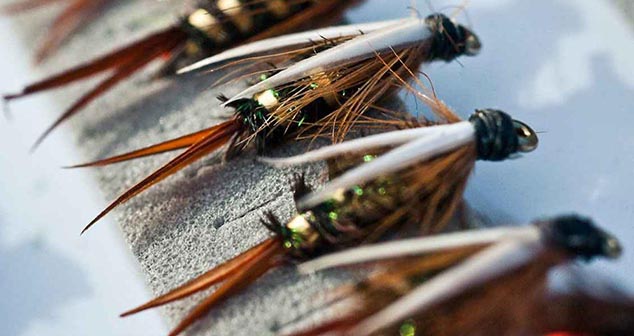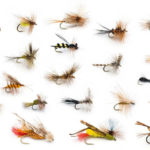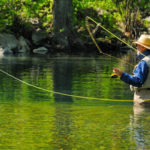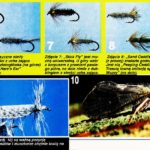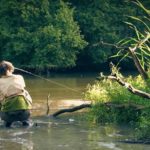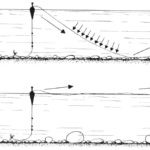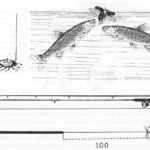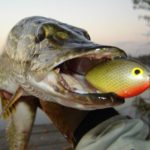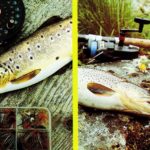Gdyby konsekwentnie korzystać z wniosków płynących z analizy pokarmu ryb, to połów na nimfy, czyli imitacje stadiów rozwojowych owadów, powinniśmy uważać za najbardziej skuteczny. Nimfy przecież to dla pstrąga i lipienia „chleb powszedni”, podczas gdy dojrzałe owady, które naśladujemy klasycznymi muchami, to raczej „potrawa świąteczna”. Jest to zrozumiałe już choćby dlatego, że podczas gdy stadia rozwojowe owadów żyją w wodzie nawet kilka lat (niektóre gatunki aż 4 lata), to dojrzały owad ma w zasadzie jednodniowe życie, w związku z czym jako pokarm ryb jest do ich dyspozycji tylko okresowo. Nimfy, oczywiście, całorocznie.
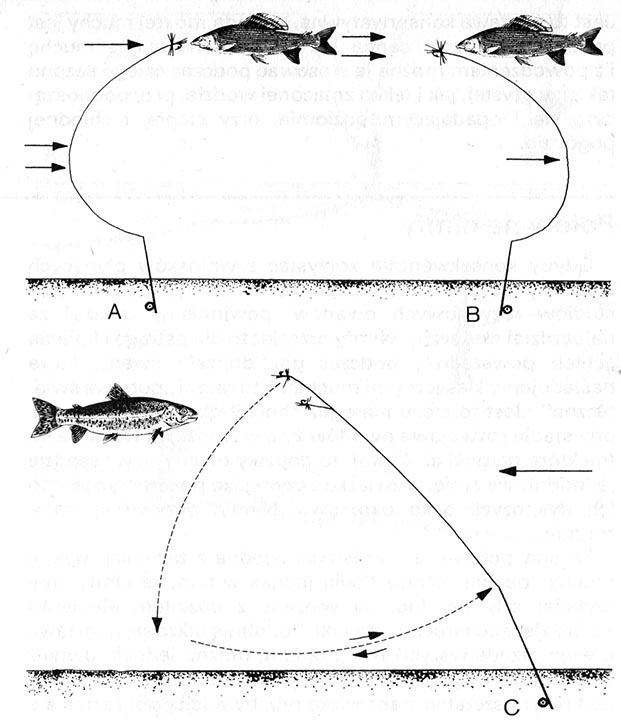 Rzut muchy w wodzie o silnym prądzie (A), w wodzie o umiarkowanym prądzie (B), skośnie w dół prądu (C)
Rzut muchy w wodzie o silnym prądzie (A), w wodzie o umiarkowanym prądzie (B), skośnie w dół prądu (C)
Zasada połowu jest w istocie zgodna z techniką mokrej muchy; pewne różnice tkwią jednak w tym, że nimfy, aby szybciej szły na dno, są wiązane z udziałem elementu obciążającego (śrucina, drucik). Podobnie także się nimi łowi, a więc przede wszystkim z prądem, można jednak również prostopadle do prądu czy nawet pod prąd. Przynętę rzucamy nad przypuszczalne stanowiska ryb, by w ich pobliże dostała się niepostrzeżenie, zniesiona prądem wody. Własny ruch nimfy zależy od tego, jaki gatunek ma być naśladowany. W naturze możliwości ruchowe nimf są ograniczone, a ich ruch jest najczęściej bierny.
W początkowym okresie stosowania tej metody łowiono tylko za pomocą linek tonących. Współcześnie natomiast wyróżniamy dwie odmiany:
a) Połów na nimfę z użyciem linki tonącej.
Tonącą linkę stosuje się w przestronnych głębokich wodach, a obławia się przede wszystkim głębsze miejsca (doły). Rzuca się skośnie pod prąd w taki sposób, by przynęta zanurzała się i spływała samowolnie, linką kieruje się tak, żeby jej ruch nie przenosił się na przynętę. Branie można zauważyć tylko dzięki lince trzymanej między palcami, niekiedy także sygnałem jest jej zatrzymanie się.
Wybór tego czy innego typu linki tonącej zależy od charakteru łowiska; jeżeli prąd wody jest silniejszy to pożądana będzie linka szybciej tonąca. Do połowu w wodach stojących można wykorzystać linkę kombinowaną; taką, której tylko część tonie,
b) Połów na nimfy z użyciem linki pływającej W stosunku do linki tonącej jej zalety są następujące:
– branie daje się łatwiej zaobserwować;
– przynęta (nimfa) jest prowadzona w bardziej naturalny sposób, z prądem.
Rzuca się pod prąd lub skośnie pod prąd i pozwala się nimfie swobodnie spływać. Nadmiar linki nieustannie zbiera się w rękę, by reakcja na branie mogła być błyskawiczna. Branie można zauważyć bądź po pojawieniu się sylwetki ryby w okolicy naszej przynęty (do tego okulary polaryzujące są niezbędne), bądź po ruchu linki, która zatrzyma się albo odchyli nieco od kierunku ruchu. Niekiedy dostrzegalne jest także pofalowanie wody w okolicy przyponu.
